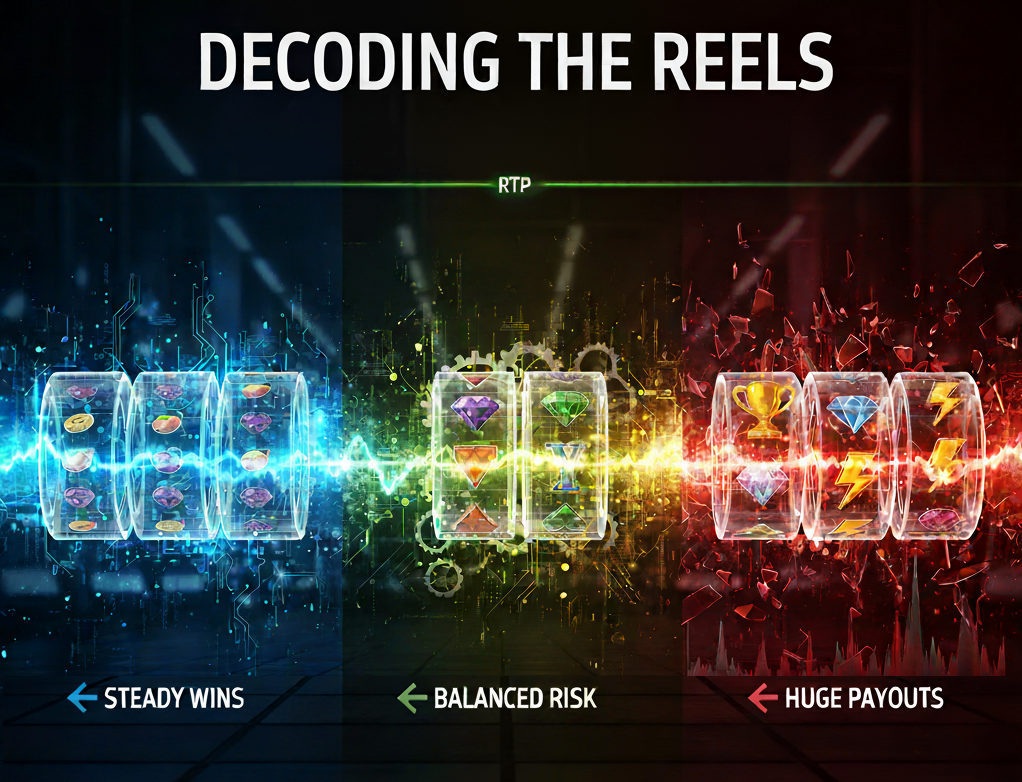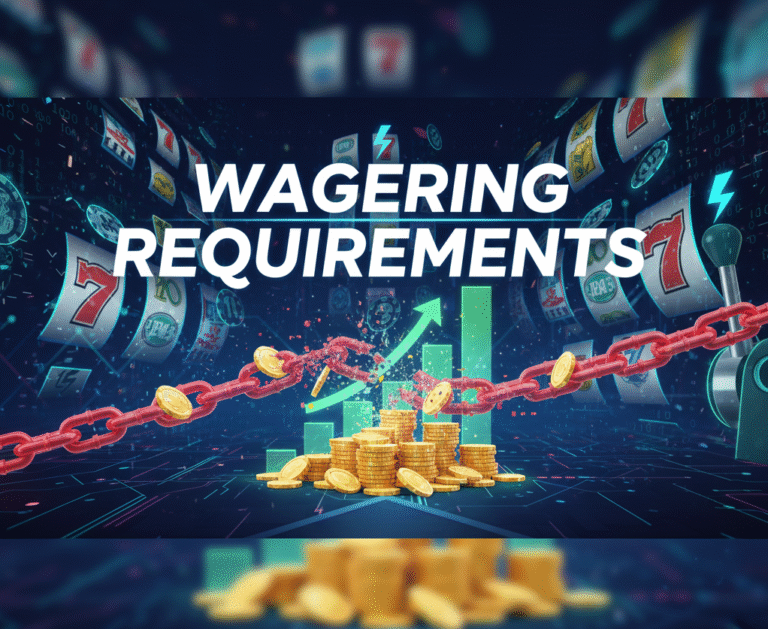Decoding the Reels: A Comprehensive Guide to Volatility in Gambling Games
The Hidden Engine of the Reels: A Guiding Compass for Volatility For many who enjoy online slots, the experience can feel like…

The Hidden Engine of the Reels: A Guiding Compass for Volatility
For many who enjoy online slots, the experience can feel like a game of pure luck. The reels spin, symbols land, and a payout either appears or it doesn’t. However, beneath the surface of flashing lights and spinning symbols lies a critical, yet often misunderstood, mechanic: volatility. Also known as variance, this concept is the hidden engine that dictates the entire rhythm of a slot machine. It is not a random occurrence but a carefully programmed risk profile that governs how often a game pays out and the typical size of those payouts over time.
Understanding volatility is essential for any player, as it acts as a compass, guiding them toward games that align with their personal goals, risk tolerance, and bankroll. A slot’s volatility is a deliberate design choice, a mathematical model finely tuned by developers to create a specific type of experience. It’s the difference between a game that offers a steady stream of small rewards and one that subjects a player to long, tense periods without a win, punctuated by the potential for a massive, exhilarating payout. This guide aims to demystify this critical concept, transforming the act of choosing a game from a blind guess into an informed, strategic decision.
Volatility vs. RTP: The All-Important Distinction
Before exploring the different levels of volatility, it is crucial to first distinguish it from another key metric: Return to Player, or RTP. While both terms are fundamental to understanding a slot’s payout behavior, they measure entirely different aspects of the game’s design. A clear understanding of how they work together is essential for any player.
What is Volatility? The Journey.
Volatility is best understood as the journey of a gaming session. It is the measure of a slot machine’s risk, specifically the degree to which its payouts fluctuate. A game with low volatility will have minimal fluctuation, while a game with high volatility will see dramatic swings between wins and losses. This metric tells a player what to expect in the short term: will the reels reward them frequently with small sums, or will they endure a long, tense wait for a potentially significant reward?
What is RTP? The Destination.
In contrast, RTP is the destination. It is a theoretical percentage that indicates the amount of money a slot machine is expected to return to players over the very long term, typically calculated over millions of spins. For example, a slot with a 96% RTP is programmed to return an average of £96 for every £100 wagered over its lifetime. This percentage is a statistical average and does not guarantee short-term results, as winnings and losses can vary widely in a single session due to randomness.
Why They Are Not the Same.
The most common misconception is that a high RTP means a slot will pay out frequently. This is incorrect. RTP and volatility are distinct concepts that work in tandem to define the player experience. Volatility describes
how that long-term RTP is distributed. A game with a high RTP can still be highly volatile, offering massive payouts but at a very low frequency.
Consider two different slot games, both with a 96% RTP. The first is a low-volatility slot. It may offer frequent, small wins of two or three times the player’s bet, leading to a smooth and consistent session. The second is a high-volatility slot. A player could go through 50 spins with no wins at all, only to then hit a massive payout that is 5,000 times their bet. Both games theoretically return the same amount over time, but the experience of playing them is worlds apart. This understanding reveals that a game’s RTP alone does not tell the full story; a player must also consider its volatility to anticipate the nature of their playing session.
The Volatility Spectrum: Finding Your Gaming Personality
Slot machine volatility exists on a spectrum, generally categorized into three main levels: low, medium, and high. Each level offers a unique risk-reward balance and appeals to a different type of player. Understanding these “gaming personalities” is the key to choosing a game that is not only fun but also strategically sound for a player’s budget and temperament.
Low Volatility: The Safe Bet
Low volatility slots are the most frequent payers on the market. They are designed to provide a “steady stream of smaller wins” and a less stressful gaming experience.
- Core Characteristics: Wins occur more often, but the payouts are typically much smaller. The high hit frequency helps players maintain their bankroll and extend their playtime. These games are often reminiscent of classic fruit machines or “penny and nickel slots”.
- Player Profile: Low volatility slots are ideal for casual players or those on a smaller budget. They are for individuals who prefer a consistent and reliable experience, prioritizing a longer session over the slim chance of a life-changing jackpot.
- Bankroll Management: For these games, it is advisable to use conservative bet sizes relative to the player’s total bankroll. The strategy is to enjoy the longevity of the session rather than to chase large, infrequent payouts.
- Key Features and Examples: Low volatility is often a result of simple game mechanics that reward frequent combinations. Examples include Starburst, a classic that offers frequent wins , as well as popular titles like Lucky Larry’s Lobstermania , Golden Goddess , and Fruit Zen.
Medium Volatility: The Balanced Approach
Medium volatility slots strike a balance between the extremes of the spectrum. They are one of the most popular choices for a wide range of players.
- Core Characteristics: These games offer a mix of frequent, smaller wins and the occasional decent-sized payout. The hit frequency is greater than in high-volatility games, and the payout potential is not substantially decreased.
- Player Profile: Medium volatility appeals to players who desire a bit of excitement without the sharp financial swings of high-risk games. They are comfortable with moderate winning and losing streaks and appreciate the chance for a larger payout without the prolonged tension.
- Bankroll Management: A strategy for these games involves using moderate bet sizes that can withstand occasional losing streaks without prematurely ending the session. The focus is on consistency and managing the pace of play.
- Key Features and Examples: These games often include features that offer a mix of small and large wins. Examples include popular titles like Gonzo’s Quest and Thunderstruck II.
High Volatility: The Big-Game Hunter
High volatility slots are where the action intensifies. They are built for thrill-seekers and risk-takers who are willing to endure long, tense sessions for the chance of a truly epic payout.
- Core Characteristics: Wins are much less frequent, but when they do occur, they can be substantial. These games are defined by “long dry spells” and “dramatic swings between wins and losses”. The hit frequency is low, and many wins are often less than the initial bet, which are still considered “wins” in a game’s statistics.
- Player Profile: This level of volatility caters to patient players with a larger bankroll who are willing to take significant risks for the adrenaline rush of a huge win. These games often feature massive jackpots, including life-changing progressive ones.
- Bankroll Management: Proper bankroll management is critical here. Players need a larger bankroll to absorb the long cold streaks. The recommendation is to use a very conservative bet size and to set clear loss limits before each session. A player should be prepared to lose without a single win and must avoid the dangerous habit of increasing bets to recover losses, as this “quickly accelerates bankroll depletion”.
- Key Features and Examples: High volatility is often the result of game designs that lock the major winning potential behind hard-to-trigger features like complex bonus rounds with high multipliers or progressive jackpots. Examples include Big Bass Splash , Book of Dead , and Dead or Alive. Some developers have even introduced “Extreme” and “Insane” volatility levels, such as those from Nolimit City, offering even rarer but potentially enormous wins.
Volatility at a Glance: A Quick Comparison
The following table provides a quick-reference summary of the characteristics of each volatility level, offering a clear guide to help players choose a game that fits their style.
| Category | Low Volatility | Medium Volatility | High Volatility |
| Payout Frequency | More Frequent | Balanced | Less Frequent |
| Payout Size | Smaller | Mix of Small and Large | Larger |
| Risk Level | Lower | Moderate | Higher |
| Player Profile | Casual, smaller budget | Seeks balance of risk and reward | Patient, risk-taker, larger budget |
| Bankroll Needed | Smaller | Moderate | Larger |
| Player Experience | Consistent, steady flow of wins | Balanced, occasional excitement | Dramatic swings, long dry spells |
Export to Sheets
In-Depth Case Studies: Volatility in Action
The theoretical concepts of volatility come to life when examining specific games. A slot’s volatility is a direct outcome of its core mechanics and features. By analyzing the design of popular examples, it becomes clear how developers engineer a particular rhythm and risk level for each game.
Starburst: The Reliable Classic
Starburst, developed by NetEnt, is a quintessential example of a low-to-medium volatility slot. Its design is built for consistent entertainment and frequent wins.
- Mechanics Analysis: The engine of Starburst’s low volatility is its iconic “Win Both Ways” paylines and the “Starburst Wilds” feature. When the multi-colored star symbol lands on reels two, three, or four, it expands to fill the entire reel, becoming a wild. This wild reel then locks in place, triggering a free re-spin. It is possible to trigger up to three wild reels in a single round, with the reels locking in place for consecutive re-spins. This mechanic creates a game where the player is constantly earning smaller, frequent payouts, keeping the game moving at a steady, enjoyable pace. The maximum win of 500x a player’s bet is a moderate amount, which aligns perfectly with its low-risk nature.
- Player Experience: The game offers a constant, engaging experience. The anticipation of the expanding wilds and re-spins keeps players engaged with a high hit frequency and minimal financial risk. It’s a game that feels “safe” and consistent, making it a favorite for those who prefer to stretch their bankroll and enjoy a longer session.
Eye of Horus: The Balanced Expedition
The Eye of Horus slot is typically categorized as a medium-to-high volatility game, offering a practical balance between the frequent wins of a low-volatility game and the explosive potential of a high-volatility one.
- Mechanics Analysis: The game’s risk profile is tied to its central bonus feature: the symbol upgrade mechanic within the Free Spins round. While the base game offers more frequent, smaller wins, the potential for a significant payout is unlocked when the player lands three scatter symbols, which awards 12 free spins. During these free spins, each time the Horus wild symbol appears, it not only expands to cover the reel but also upgrades one of the low-paying symbols to the next highest value. This feature can lead to a domino effect of progressively more valuable wins, culminating in substantial payouts that are not possible in the base game.
- Player Experience: The gameplay is an engaging mix of anticipation and payout. The player experiences a consistent rhythm in the base game while holding out for the bonus round, which holds the promise of a more rewarding outcome. This provides the thrill of a big win without the extreme dry spells associated with the highest-risk games.
Big Bass Splash: The Big-Game Hunter’s Choice
Big Bass Splash, from Pragmatic Play, is a classic high-volatility slot, rated 5 out of 5 for its risk level by the studio.
- Mechanics Analysis: The game’s high-risk nature is a direct result of its design. The hit frequency is low, with a winning combination landing only once every 7.32 spins on average. The core of the game’s high payout potential is locked within the Free Spins feature, which is difficult to trigger, landing on average once every 113 spins. When triggered, a player gets between 10 and 20 free spins, where the “Fisherman Wilds” can collect “Fish Money” symbols with random values. By collecting more wilds, the player can retrigger the feature and apply a multiplier of up to 10x to these fish symbols, leading to the game’s maximum win of 5,000x the bet. This payout structure means the game is designed for players to endure long periods without a win, all for the chance of a single, explosive payout.
- Player Experience: Playing this game requires a high level of patience and a significant bankroll. The excitement is not in the frequent payouts, but in the anticipation of the highly sought-after bonus round. When the bonus finally hits, the potential for a massive payout provides an unparalleled adrenaline rush that justifies the risk.
Case Study Summary: The Examples Compared
| Game | Volatility Level | RTP | Max Win | Key Defining Feature | Player Takeaway |
| Starburst | Low-Medium | 96.10% | 500x | Win Both Ways, Expanding Wilds with Re-spins | A consistent, steady experience with frequent small wins. |
| Eye of Horus | Medium-High | 96.31% | 500x (Megaways) | Free Spins with Symbol Upgrades | A balanced experience with the potential for decent payouts in the bonus. |
| Big Bass Splash | High | 96.71% | 5,000x | Free Spins with Multipliers and Symbol Collection | A high-risk, high-reward hunt for a rare, massive win. |
The Pragmatic Player’s Guide: How to Identify Volatility Yourself
A truly informed player can “read” a game’s design to predict its volatility even without an explicit rating. By paying attention to a few key clues, a player can make a choice before they wager their money.
- The Paytable Clue: The most direct way to gauge volatility is to examine the game’s paytable. If the paytable shows a huge difference between the payouts for the lowest and highest-paying symbol combinations, it is a strong indicator of high volatility. Conversely, a paytable with many smaller, frequent payouts for various combinations likely signifies a low-volatility game.
- Analyze the Bonus Features: The nature of a game’s bonus features can also reveal its risk profile. Slots with complex, hard-to-trigger bonus rounds that offer massive multipliers or progressive jackpots are almost always high-volatility. Similarly, “Hold and Win” features, where respins are used to collect special symbols, are designed for high-risk play. In contrast, games with simpler bonus features that are easier to trigger typically have lower volatility.
- Play in Demo Mode: The best way to get a feel for a game is to play it in a free-play or demo mode. A short session of 50 to 100 spins can provide valuable insight. If wins are frequent, even if small, it’s a low-volatility game. If the reels remain stagnant for many spins, with wins being rare but potentially significant, it is likely a high-volatility slot.
- Research the Game: Many developers, such as NetEnt and Pragmatic Play, explicitly list a game’s volatility rating in the game information section or paytable. Additionally, reputable casino blogs and game review sites often include assessments of a game’s volatility in their reviews, providing a valuable external perspective.
Playing Smarter, Not Harder
In the world of online gambling, understanding a slot game’s volatility is paramount to a successful and enjoyable experience. This report has demonstrated that volatility is the single most important factor in determining the “feel” and rhythm of a game, far more than its theoretical RTP. A player must recognize that low volatility is about consistent, prolonged enjoyment, medium volatility offers a balanced blend of excitement and stability, and high volatility is a high-stakes pursuit of a single, monumental win.
The central conclusion is that a player’s choice of game should not be random; it must be a conscious decision based on their goals and risk tolerance. Understanding volatility puts the player in control, allowing them to make informed choices that align with their personal bankroll and expectations. By taking the time to “read” a game’s design—whether through its paytable, bonus features, or simply by observing its rhythm in demo mode—a player can ensure they are playing a game that truly suits them, thus maximizing enjoyment and avoiding the frustration of mismatched expectations.





